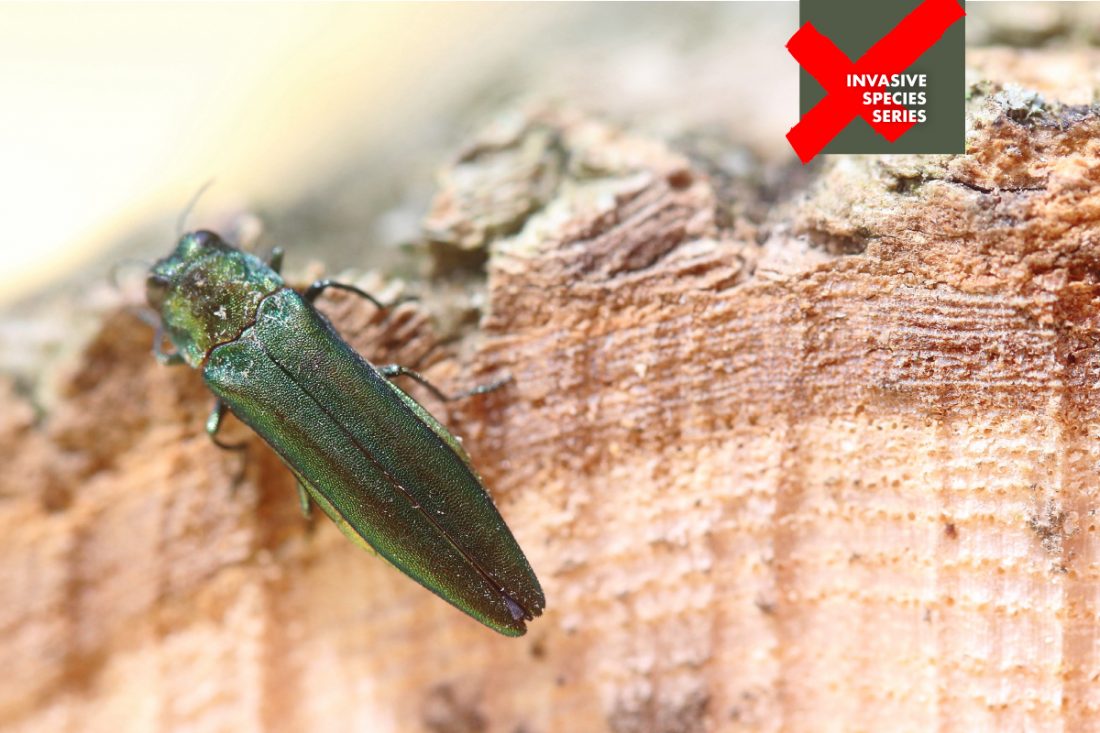
All photos courtesy of the author.



All photos courtesy of the author.
May is Invasive Species Awareness Month in Illinois. Why do we even need an invasive species awareness month? Why is it in May? How and when did it get started?

Let us start with why an awareness month is needed. Invasive species are a huge threat to natural resources, native species and outdoor recreation throughout Illinois. The Illinois Wildlife Action Plan lists managing invasive species as one of the six primary threats to conservation in Illinois. Regardless of where you are at, or what type of habitat type you are in, invasive species are an issue. For example, the invasive zebra mussel can cover everything in a water body, clogging pipes and overwhelming native mussels. Bush honeysuckle forms dense thickets that dominate a forest understory, excluding native plants and slowing the growth rate of overstory trees. Emerald ash borer has killed millions of native ash trees across Illinois and continues to decimate ash trees. There are many other examples. One thing the different invasive species in Illinois have in common is that they do not recognize property boundaries and readily move throughout the landscape, impacting both private and public lands.
Combatting invasive species requires cooperation across the landscape and everyone has a role to play. Landscapers can choose not to plant invasive species. Landowners can control invasives on their land. Outdoor recreationists can clean their clothing and equipment to prevent the spread of invasive species. Anyone can volunteer at invasive plant control workdays. The first step to combatting invasive species is awareness. The more Illinoisans that know about invasive species and are willing to take action, the better our ability to manage our natural resources. Having a month dedicated to raising awareness about invasive species helps highlight the need and provide avenues for events and programs.

Why was it decided that May was going to be Invasive Species Awareness Month, especially given that National Invasive Species Awareness Week is in February each year? The decision was made for two primary reasons, garlic mustard and spring wildflowers. Garlic mustard is an aggressive invasive plant that invades forests. It is highly visible and easily identifiable in April and May when it is flowering. Garlic mustard pulls are great volunteer events to introduce people to invasive species. The plants are easy to recognize, the work is safe and requires little specialized training, and the results of pulling garlic mustard are instantly visibly obvious. Many Illinois groups were already holding events that focused on removing garlic mustard from forests during May. One great example is the series of volunteer events in the annual Great Garlic Mustard Hunt put on by the East Central Illinois Master Naturalists. In addition to the prime opportunity for controlling garlic mustard, May also is a wonderful time to be out in nature. The weather is often nice and many of our native spring wildflowers are in bloom. Valuing our native ecosystems and understanding what is at risk from invasive species is a vital part of raising awareness.
Awareness month started in southern Illinois in 2010 as a grass roots effort to increase the public’s knowledge and awareness of invasive species in the region. The idea quickly caught on and, with the backing of the former Illinois Invasive Plant Species Council, it spread statewide. Initially awareness month was unofficial, but with the advocacy of several non-profit organizations and the backing of agencies such as the Illinois Department of Natural Resources and the Illinois Department of Agriculture, a proclamation was signed in 2012 by then Governor Pat Quinn to officially establish May as Illinois Invasive Species Awareness Month.

For the first five or six years, awareness month was running full steam. Organizations, businesses and agencies all partnered together to host local events. Between 80 and 120 events were scheduled and placed on a shared calendar each year. In addition to garlic mustard pulls and guided hikes, other awareness events included boat cleaning demonstrations, children’s events, presentations, field tours, control demonstrations, webinars, and workshops. While the concerted, coordinated effort has slowed down as of late, Illinois Invasive Species Awareness Month continues to serve as a rallying point for invasive species educational efforts. The University of Illinois Extension provides a great example of recent efforts to raise awareness using different online media. Throughout the month of May in 2021, Extension utilized webinars, blog posts, infographics, fact sheets, podcasts, and social media posts to highlight different invasive species and Illinois invasive species projects.
The annual Illinois Invasive Species Symposium has served as an unofficial grand finale of Awareness Month. The May 4, 2023 event provides an opportunity to hear from researchers and practitioners about invasive species projects and programs underway in Illinois. Over the years the symposium has included presentations on feral swine, exotic wood boring beetles, white nose syndrome on bats, volunteer projects to control invasive plants, aerial control of invasive shrubs, educational outreach efforts, and much more.
There is still a strong need for raising awareness about invasive species in Illinois and events are still being planned each May. Join in a local volunteer work day, attend a guided hike, or tell your neighbors why you are concerned about invasive species. Happy Illinois Invasive Species Awareness Month!
Chris Evans is an Extension Forestry and Research Specialist with the University of Illinois. A focus of his research and extension activities is invasive species management and forest health. Evans is currently a board member for the Midwest Invasive Plant Network, president of the southern chapter of the Illinois Native Society and a former board member of the North American Invasive Species Management Association and the National Association of Exotic Pest Plant Councils.
Submit a question for the author